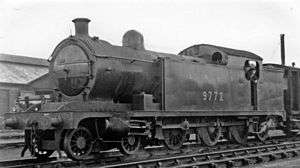NER Class Y
|
No. 9772 at Hull Dairycoates Locomotive Depot 1947 | |||||||||||||||||||||||||||||||||||||||||
| |||||||||||||||||||||||||||||||||||||||||
| |||||||||||||||||||||||||||||||||||||||||
| |||||||||||||||||||||||||||||||||||||||||
| |||||||||||||||||||||||||||||||||||||||||
The North Eastern Railway (NER) Class Y (LNER Class A7) 4-6-2T tank locomotives were designed whilst Wilson Worsdell was Chief Mechanical Engineer, but none were built until 1910 by which time Vincent Raven had taken over.
Overview
The Class Y locomotives were intended for hauling coal trains and were developed from the NER Class X (LNER Class T1) 4-8-0T heavy shunters. However, they had larger boilers and smaller cylinders for higher working speeds. Twenty were built in one batch and numbered between 1113 and 1195. Originally built with saturated boilers pressed to 175 lbf/in2 (1.21 MPa), seven locomotives were later fitted with boilers equipped with superheaters and pressed to 160 lbf/in2 (1.10 MPa).[1]
All twenty locomotives passed to the London and North Eastern Railway at the 1923 Grouping. The LNER left the NER's locomotive numbers unchanged, but raised the boiler pressure of the saturated locomotives to 180 lbf/in2 (1.2 MPa). They also fitted ten more locomotives with the 160 lbf/in2 superheated boilers that the LNER classified as diagram 55.
By the time the A7s entered LNER ownership in 1923, the A7s had been relegated to shunting in the larger marshalling yards. Their power was invaluable when shunting heavy trains over the shunting hump. In the 1930s, Nos. 1136 and 1175 were allocated to hauling chalk quarry trains from Hessle Quarry to Stoneferry Cement Works, in the Hull area.
Heavy mineral traffic declined after the end of World War II, and the A7s moved to the Hull area, except for Nos. 1181 and 1192 which stayed at Stockton. At Hull, the A7s replaced the old Hull and Barnsley Railway (H&BR) types which were being withdrawn at that time.
During LNER ownership in the 1940s, two locomotives were rebuilt with diagram 63B superheated boilers pressed to 175 lbf/in2; the locomotives were then assigned to Class A7/1.
In the LNER 1946 renumbering scheme, the class received the 9770 to 9789 block; at nationalisation in 1948 all 20 locomotives passed to British Railways they were assigned the numbers 69770–69789, although the last locomotive was withdrawn before it was renumbered.
BR continued the rebuilding scheme, dealing with another 13 locomotives, although one received a diagram 63B saturated boiler and one a diagram 63C superheated one. Both were pressed to 175 lbf/in2.
Withdrawal
The A7s were withdrawn between 1951 and 1957 and none have survived into preservation.
| NER No. | LNER 1942 No. | Date built | Date superheated | Date rebuilt | Date Withdrawn | Notes |
|---|---|---|---|---|---|---|
| 1113 | 9770 | Oct 1910 | May 1922 | Jul 1950 | Oct 1954 | |
| 1114 | 9771 | Nov 1910 | Sep 1924 | Jun 1948 | Nov 1954 | |
| 1126 | 9772 | Nov 1910 | Jul 1917 | — | Dec 1957 | |
| 1129 | 9773 | Dec 1910 | Oct 1930 | Jul 1951 | Mar 1955 | |
| 1136 | 9774 | Dec 1910 | May 1932 | May 1950 | Aug 1954 | |
| 1170 | 9775 | Dec 1910 | — | Nov 1945 | Apr 1952 | |
| 1174 | 9776 | Jan 1911 | Jan 1930 | Jan 1952 | Jun 1954 | |
| 1175 | 9777 | Jan 1911 | May 1919 | — | May 1952 | |
| 1176 | 9778 | Feb 1911 | — | — | May 1955 | |
| 1179 | 9779 | Feb 1911 | Feb 1929 | Dec 1949 | Nov 1954 | |
| 1180 | 9780 | Feb 1911 | Dec 1930 | Jan 1950 | Nov 1954 | |
| 1181 | 9781 | Mar 1911 | Mar 1929 | Apr 1951 | Nov 1956 | |
| 1182 | 9782 | Mar 1911 | Mar 1923 | — | Dec 1957 | |
| 1183 | 9783 | Mar 1911 | Nov 1928 | Apr 1948 | Dec 1956 | |
| 1185 | 9784 | Apr 1911 | Mar 1922 | May 1948 | Mar 1956 | |
| 1190 | 9785 | Apr 1911 | Nov 1918 | Sep 1943 | Nov 1955 | |
| 1191 | 9786 | May 1911 | Apr 1930 | Apr 1948 | Dec 1957 | Rebuilt with superheated dia 63C boiler |
| 1192 | 9787 | May 1911 | — | Aug 1951 | Aug 1954 | Rebuilt with saturated dia 63B boiler |
| 1193 | 9788 | May 1911 | Sep 1920 | Jul 1948 | Nov 1955 | |
| 1195 | 9789 | Jun 1911 | Nov 1922 | — | May 1951 | Withdrawn before BR number applied |
References
- Fry, E. V., ed. (April 1964). Locomotives of the L.N.E.R., part 7: Tank Engines - Classes A5 to H2. Kenilworth: RCTS. ISBN 0-901115-13-4.
- Ian Allan ABC of British Railways Locomotives, 1948 edition, part 4, page 55
